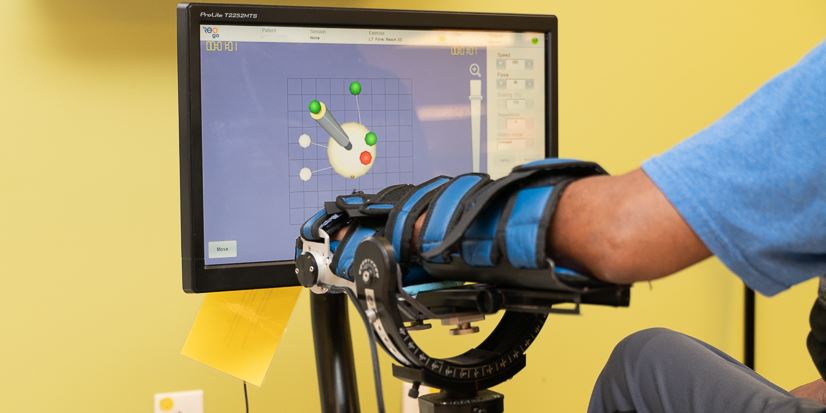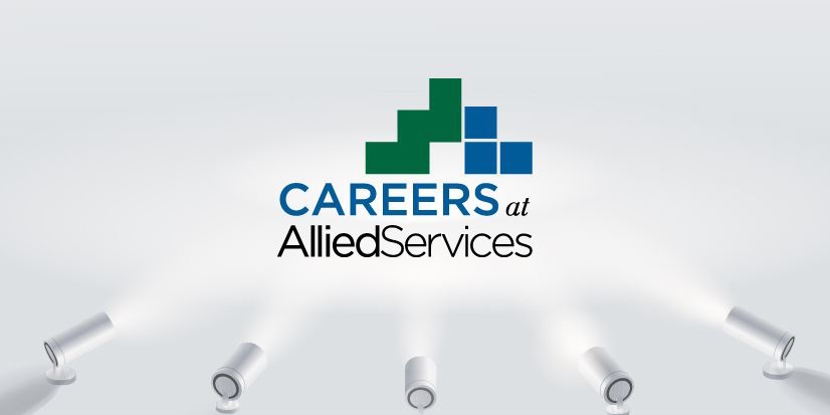Stroke Recovery: Larry's Story
- Category: News, Stroke Recovery
- Posted On:
- Written By: Allied Services Integrated Health

“Last June (2020), I was driving home from work when I felt a feeling like I had never felt before in my head. I started to feel so disorientated. It was so strange I had to pull over.”
“I stopped in a parking lot and when I went to get out of my car, I just fell over. I had no feeling and no use of the entire left side of my body. I tried to climb back up into my car with only my right arm, but I just remember getting so incredibly tired. I just couldn’t fight it - and I passed out. I don’t remember anything after that.”
“Later I found out my wife had called the police when I didn’t come home. After some time they told her they had found my car nearby and there was an ambulance tending to me. A passerby had seen me lying outside my car and called 9-1-1. I will be forever grateful to that person. I don’t know who they are, but they saved my life.”
Larry was transported to an area hospital where they discovered that the 43-year-old had suffered a large Basal Ganglia Hemorrhage, the most severe type of stroke.
Types of Strokes
The three main types of strokes are ischemic, hemorrhagic, and transient ischemic attack (TIA).
- Ischemic strokes are the most common type of stroke. They occur when the arteries carrying blood to the brain are blocked making it impossible for blood to pass through. Arteries can be blocked by a blood clot or by a condition known as atherosclerosis. An estimated 87 percent of all strokes are ischemic.
- Hemorrhagic strokes are a less common type of stroke, but do account for about 40 percent of all stroke deaths according to the National Stroke Association. Hemorrhagic strokes occur when the blood vessels leading to or around the brain leak or rupture (tear) causing blood to pour into the surrounding brain tissue.
- A Transient Ischemic Attack (TIA), more commonly referred to as a “mini-stroke”, is a stroke that lasts only a few minutes. Symptoms of aTIA are like other stroke symptoms; one-sided numbness or weakness, vision loss, speech difficulty, etc., but do not last as long. They resolve with no lasting damage however, these events can be a warning sign that a more severe type of stroke might occur in the future.
The most common cause of hemorrhagic stroke is uncontrolled high blood pressure. Larry was on medication for his blood pressure, but wonders if a recent increase in his stress level at the time of his stroke may have played a role.
“I had just had a visit with my doctor a few months prior and my blood pressure was good, low even. I was on a low dose of my blood pressure medicine and everything was fine. I was under a lot of stress at work, but I had no sign anything like this was going to happen.”

Stroke and Brain Injury
Any stroke is a serious, life-threatening medical condition. Your symptoms and how you're affected by a stroke depend on its location, its severity, and how quickly you receive treatment.
In Larry’s case, both the location and type of stroke were critical. The basal ganglia are a collection of cell bodies that lie deep in the center of the brain. They serve as the message center for a range of bodily functions including movement, personality, muscle control, sensation, and some aspects of thinking. Differing from an ischemic stroke when a blood vessel is blocked, Larry’s hemorrhagic stroke caused an artery to rupture flooding the surrounding tissue with blood.
Brain tissue that is under pressure and without blood flow dies quickly, and immediate treatment is needed. Fortunately, Larry’s hemorrhagic stroke was found quickly and surgeons were able to perform a procedure to relieve the pressure and control the bleeding. Due to the delicate and complex nature of our brain tissue, there was still damage to some of the sensory and motor functions on Larry’s left side.
“I am one of the lucky ones. Most of the people that I know, or that I have heard of that have brain surgery don’t come out of it. They are in a coma or there is too much damage and they just never wake up. For me, thank God, I am a success. I woke up right away. I had no swelling in my brain. Yes, I had paralysis on the left side, but I am still here and I am working through it.”
Once stable, Larry moved on from the acute care hospital to Allied Services Wilkes-Barre Rehab Hospital. From there, he transitioned home with the help of home health, before continuing his rehabilitation at Allied Services Wilkes-Barre Rehab Center.
“When I started I had no use of my left arm. I had a brace on my left leg and I had to use a quad cane to walk. I would say to myself, I don’t know if I will ever walk normal again or be able to use my hand, but coming here I started to have a different experience. The therapists here - Jackie, Mark, Lori - they don’t judge you. They just care for you the best way they can. So for me, I was very fortunate to have them care for me.”
“After his stroke, Larry had decreased motor function on the left side of his body. During our physical therapy sessions, we would work together to improve his strength, stability, and mobility to the point where he no longer needed the brace on his leg anymore. He graduated from his quad cane to a single, and rarely needs that now,” noted Dr. Jacqueline Pearson, PT, DPT, Allied Services Wilkes-Barre Rehab Center.
Larry worked with his occupational and physical therapy teams two hours a day, twice a week from September through December. As Coronavirus cases began to rise, he became leery about going out for appointments and felt safer in his home. For a short time, he opted to receive physical therapy in his home through a program offered by Allied Services known as “Therapy Your Way”.
“During the pandemic, for patients who may have felt anxious about leaving their homes to receive some of their therapy services - the program allowed me to transition some programs to their homes until they were comfortable coming back to the clinic. In Larry’s case, this was great for both of us. He was able to receive physical therapy in his own home, and I was able to assess him in his element and see what else we needed to work on to ensure he would be safe. All while never losing any progress that we had made,” noted Pearson.
“When I came back to the outpatient rehab center, Jackie and I continued to work on walking, and Lori (occupational therapist) and I started working on my hand again. My hand went from moving just a little bit, to now, I can do so much! All kinds of things that I couldn’t do before - things that I didn’t think I would ever be able to do again. She is the best.”
“I love coming here. I love coming to therapy. I am very, very happy.”
“Sometimes I wonder, if I never got out of my car - I think I would have died because people would have thought I was just sleeping in my car and never called 9-1-1.”
“I am gratefully to be alive. I am grateful to my therapists. I am grateful to be able to sit down and share my story with you.”
Recognizing the early symptoms of a stroke is the best way to help a person get medical treatment quickly. Medical professionals and groups like the American Heart Association urge everyone to learn the acronym F.A.S.T., most now adding the letters B and E to form the acronym B.E.F.A.S.T. to help everyone remember common stroke warning signs. Learn more here.



